The last couple of years have transformed the retail industry. Technological innovation, rise of sustainability concerns, increased customer power and Covid-19 pandemic have forced retailers across the world to adopt new policies and tools to stay on the market.
See how Microsoft Teams can empower your retail workers, reshape the way they work and help your organization achieve more.
Collaboration challenges in the retail industry
Having information and conversations in different places
One of the key challenges in retail is using multiple channels of communication for internal conversations. That also includes the use of shadow IT with all the security risks that it implies. Additionally, many retail workers still manually fill out forms and hand them to managers. Having information and conversations in separate places slows down the collaboration process and affects productivity of the entire staff.
Getting feedback and adapting
Customer experience has become a top business priority across all the industries, and retail is no exception. Recent studies show that when it comes to making a purchase, 64% of people find customer experience more important than price. Therefore, getting customer feedback and implementing the necessary changes are key to retaining customers.
Agility
The retail industry has experienced massive transformation recently, with innovation, technology, and sustainability dictating the rules of the market. In order to stay afloat, retailers require agility in the way they respond to these changes. They need to find a way to respond faster to new realities and better interact with consumers for an enhanced customer experience.
Operating retail activities across all the shops
Coordinating operations across all the shops can be quite a challenge for multi-chain stores. Doing so efficiently requires a platform that would unify all the branches under one roof. At the same time, it should provide all the tools to manage each store’s activities both independently and in agreement with the core office.
Microsoft Teams solutions for retail
Fast and easy communication
Microsoft Teams provides companies across all the industries with the necessary tools and expertise to do their job better. Your employees can use their personal smartphones to communicate with their entire shift, managers, or colleagues from different geographical locations. They can send instant messages and receive notifications, reply to conversations in channel, share feedback, have video meetings, as well as fill out documents – all in one spot.
With Microsoft Teams your workers no longer need to juggle between different communication channels and resort to shadow IT to do their job. It increases their engagement and decentralizes the organizational structure.
Shift management
You can reduce the amount of paperwork for reporting and improve employee experience by using Shifts in Microsoft Teams. This employee management app gives your workers more control over their shifts. They can manage their schedules, swap requests, time off and open shift requests and more.

Agility with Planner
Microsoft Teams empowers retailers with the tools required for more organized and agile work, faster response and getting the job done in a more efficient way.
Planner with Microsoft Teams allows your workers to set and coordinate tasks both at scale and in one location. Planner gives you all the necessary tools to reduce the time it takes to implement, track, and supervise tasks.

Set up your team targeting hierarchy to allow your organization to publish content to a large set of teams. Here’s an example of how hierarchy is represented in Planner. After creating tasks, members of the publishing team can select the recipient team to send the task list to. This way, you can coordinate activities of different stores in your chain.

Push-to-talk experience
You can turn your employees’ personal and company-owned devices into a walkie-talkie with Microsoft Teams feature for first line workers. Walkie-Talkie in Teams enables instant voice communication over the cloud. It can also be used across geographic location since it works on Wi-Fi and cellular data. No longer do your first-line workers need to carry additional devices for internal communication, reducing the costs on IT.
Knowledge retention with Stream
By integrating Microsoft Stream in Teams, you can increase your employee engagement and knowledge retention and education. Your workers can also upload, manage, and share videos across the entire organization.
Moreover, users can interact with content shared in Stream. For example, you can transcribe the speech from the recording and then it can be searched for reference from keywords.
You can also use Stream to add and organize recordings of your video meetings and conferences.
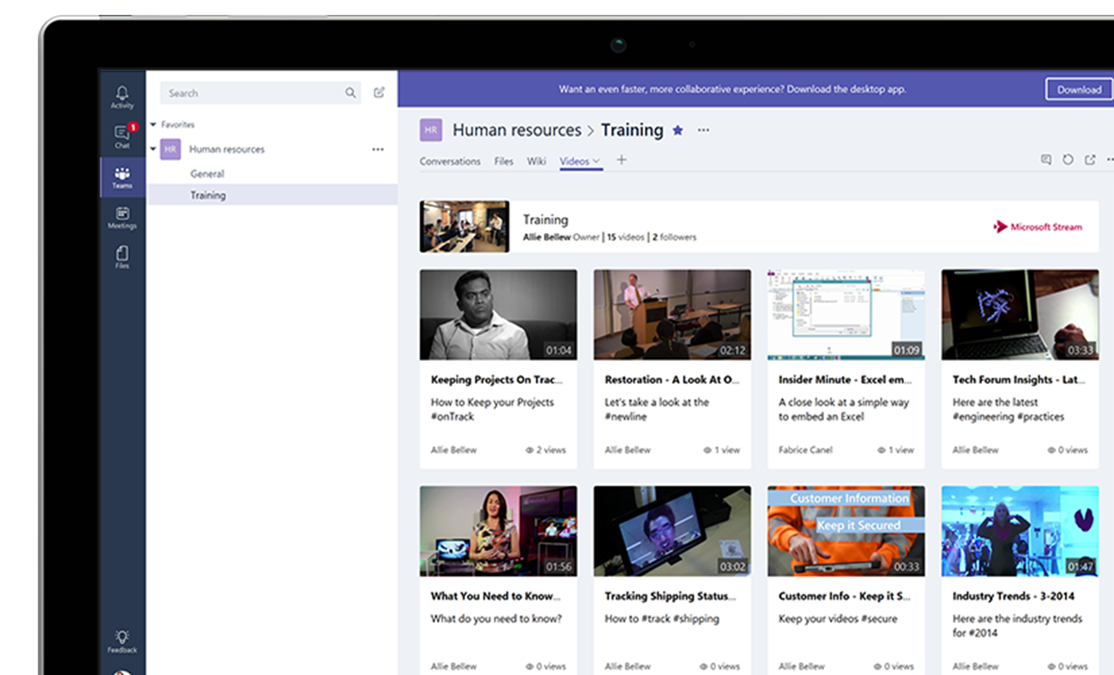
Communities
Communication at the corporate level is as important as communication within a team. It is key to creating a sense of community, increasing engagement, adding transparency, and building employee advocacy.
Many organizations are looking for effective ways to create a dialogue and share important news and announcements at the company-wide level.
With Yammer Communities in Teams you can share updates, give, and receive feedback and create social and emotional connection with your entire staff.

Integrations
With Microsoft Teams you can personalize your collaboration workspace by adding various integration. If your retail company is using leading third-party workforce managing systems – such as Kronos and JDA – for scheduling time and attendance, you can integrate them directly with Shifts via Shifts Graph APIs and SDK.
Similarly, you can integrate your own line-of-business application or other third-party apps into your Teams environment.
Microsoft Cloud for Retail
Microsoft has introduced Microsoft Cloud for retail, bringing together different data sources and delivering more relevant personalized experiences to consumers. Its new capabilities allow you to:
- Better understand your customers
- Personalize customer journey
- Provide hands-off shopping experience
- Empower your employees
- Build resilient supply chains, and more
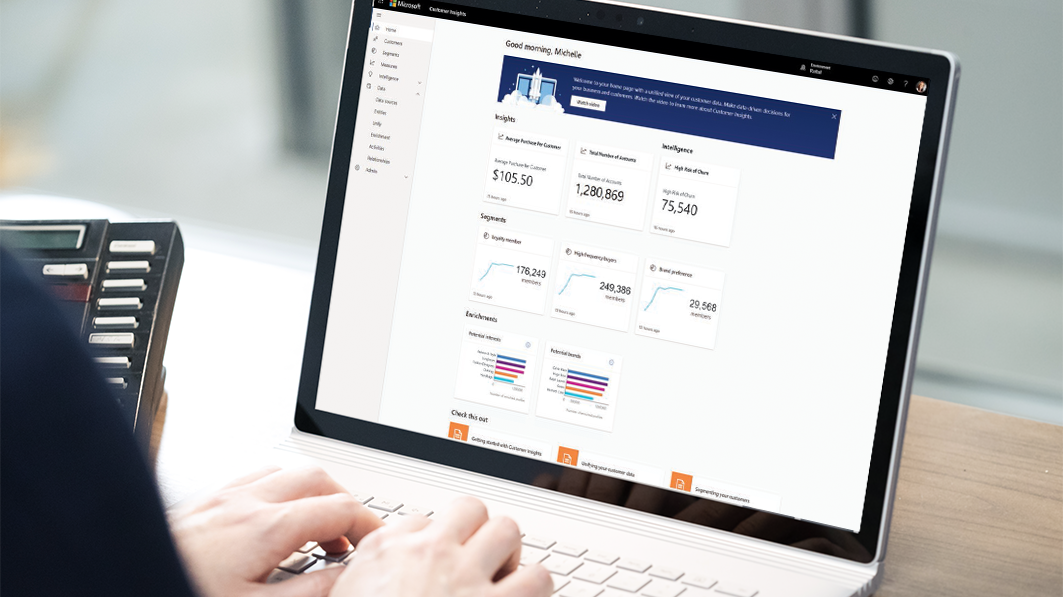
Learn more about Microsoft Cloud for Retail.
Microsoft Teams templates for retail
Apart from having an organization-wide team, each of your store locations will require a separate team in Microsoft Teams. Your staff in each store will be able to better coordinate their activities and manage in-store operations.
Additionally, you may want to create teams for launching new products where your retailers will work together with their colleagues from marketing, sales, and other departments.
Instead of creating each of these teams from scratch, you can leverage Microsoft Teams Collaboration templates with pre-build channels, files, and tabs as well as advanced governance policies, to create new teams just in a few simple steps.
Having ready-to-go teams that include all the elements your employees need to get started enables them to be more agile and productive. Additionally, all team will follow similar structure and any changes to the template will be automatically copied to teams that were based on it.
Here are some examples of how Microsoft Teams Collaboration templates can be used for retail.
Store template
If your retail company has multiple chains, you can create a Store template and use it to create standardized teams for every one of your stores. They will follow similar structure, including channels, files, integrations, as well as governance policies.
Firstly, you will need to build the Original team and include in it all the information you wish to appear in teams created from this template.
Channels
Here are channel names examples for your template:
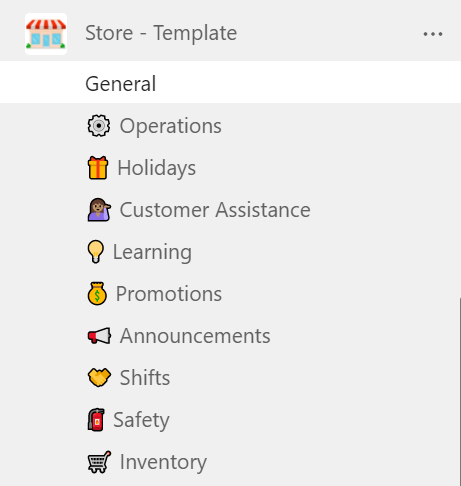
- Customer assistance
- Operations
- Promotions
- Inventory
- Holidays
- Learning
- Safety
- Announcements
- Shifts
Having multiple channels dedicated to each subject your employees work on, will help direct conversations as well as structure the collaboration process.
Files and tabs
Then, you can upload in Files tab in respective channels all the documentation that can be necessary for each of your retail chains. That can be store blueprints, safety guidelines, pricelists, etc.
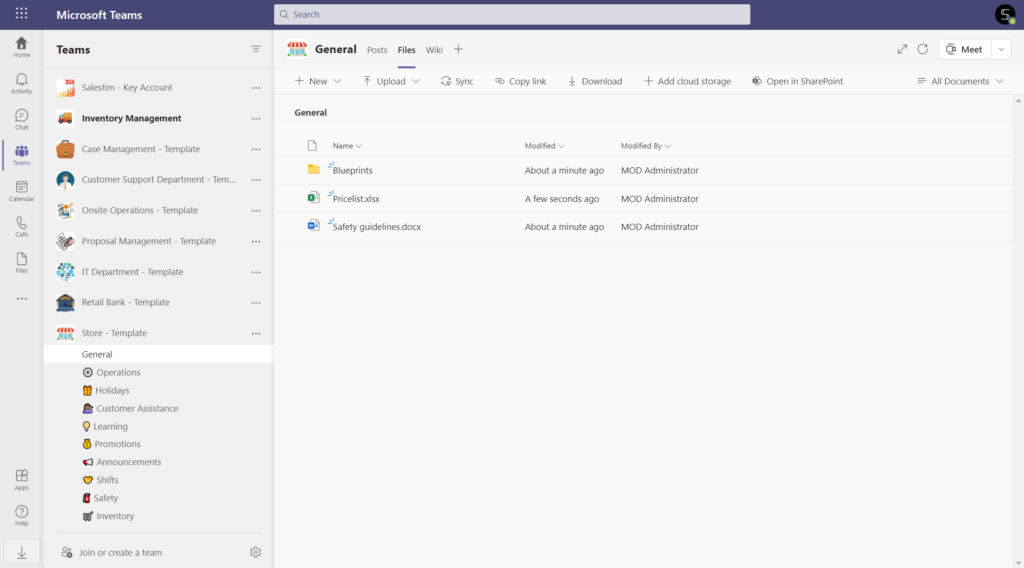
In addition, you can add and configure Planner, Shifts, Yammer, Stream, and other apps as tabs in your template. All the data you input in your apps will then be automatically cloned into newly created teams.
Product launch
Similarly, you can create a template for launching new products, and then leverage it to create fully provisioned teams in a few simple steps. This way, your employees will have all the required information ready and in one place to start working on their project straight away.
Channels
Here are some ideas for channel names for your template:

- Design
- Planning
- Promotion
- Competitors
Files and tabs
Upload all the documents that might be useful for your product launch teams and pin the most relevant ones as tabs in respective channels.
You can also pre-build Planner by adding standard tasks for a product launch. Additionally, you can integrate any other app that your organization uses in your original team.
Once the original team is fully built, you can create a template from SalesTim app. During the template creation process you may want to configure governance policies that will suit your organizational needs.

Governance policies
You can implement a Naming convention for your template, so that all the future teams created from it follow the same naming rules. For example, it may include the site location, for easier navigation among teams.
Additionally, you can set up Approval policies. In this way, all the requests for creating teams from this template will require approval from a specific person or a group of people from your organization.
You may also want to set up Audience targeting so that only specific groups of users could see certain templates.
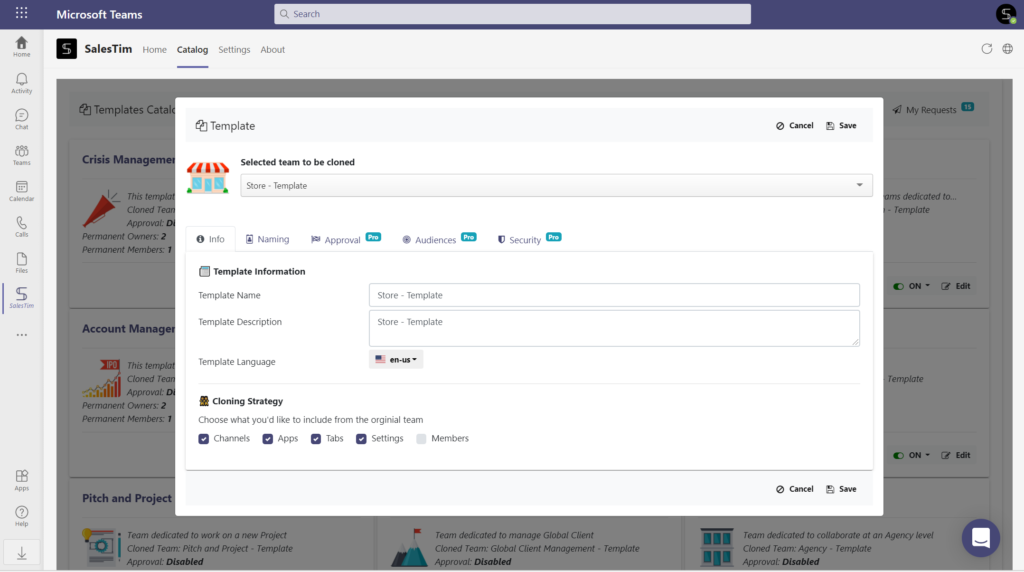
Learn more about Microsoft Teams Collaboration templates governance policies.
Feel like your retail company could benefit from Microsoft Teams templates? Contact us and we’ll find a solution tailored for your use cases.

